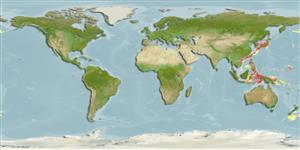>
Ophidiiformes (Cusk eels) >
Ophidiidae (Cusk-eels) > Neobythitinae
Etymology: Glyptophidium: Greek, glyptes = carver + Greek, ophis, ophidium, diminutive = serpent (Ref. 45335).
More on authors: Smith & Radcliffe.
Environment: milieu / climate zone / ระดับความลึก / distribution range
นิเวศวิทยา
เกี่ยวกับทะเล,น้ำเค็ม สัตว์หน้าดินในเขตน้ำลึก; ระดับความลึก 200 - 565 m (Ref. 34024). Deep-water
Western Pacific: Japan to the northern Philippines. Probably from off Madagascar (Ref. 34024).
ขนาด / น้ำหนัก / Age
วัยเจริญพันธุ์: Lm ? range ? - ? cm
Max length : 22.0 cm SL เพศผู้/กระเทย; (Ref. 559)
ก้านครีบอ่อนที่หาง (รวม) : 127 - 134; ก้านครีบอ่อนที่ก้น: 100 - 104. Prominent head and body with an attenuate caudal part; head bones with large, thin crests; eye equal to or greater than length of snout; opercular spine broad, flat and weak; basibranchial with 2 median and a pair of tooth patches; long gill rakers on anterior arch 21 to 33(Ref. 34024). Caudal fin rays 8-10; stem of pseudobranchial filament pale, filaments 10-15; anterior anal fin ray below 31st-34th dorsal fin rays (Ref. 34024).
Body shape (shape guide): elongated.
Common species (Ref. 34024). Oviparous, with oval pelagic eggs floating in a gelatinous mass (Ref. 205).
Life cycle and mating behavior
วัยเจริญพันธุ์ | การสืบพันธุ์ | การวางไข่ | เซลสืบพันธ์ของเพศเมีย(ไข่) | ความดกของไข่ | ตัวอ่อน
Nielsen, J.G., D.M. Cohen, D.F. Markle and C.R. Robins, 1999. Ophidiiform fishes of the world (Order Ophidiiformes). An annotated and illustrated catalogue of pearlfishes, cusk-eels, brotulas and other ophidiiform fishes known to date. FAO Fish. Synop. 125(18):178p. Rome: FAO. (Ref. 34024)
IUCN Red List Status (Ref. 130435: Version 2025-1)
Threat to humans
Harmless
Human uses
เครื่องมือ
Special reports
Download XML
แหล่งที่มาจากอินเตอร์เน็ต
Estimates based on models
Preferred temperature (อ้างอิง
123201): 9.4 - 16.1, mean 13 °C (based on 28 cells).
Phylogenetic diversity index (อ้างอิง
82804): PD
50 = 0.5156 [Uniqueness, from 0.5 = low to 2.0 = high].
Bayesian length-weight: a=0.00380 (0.00167 - 0.00864), b=3.14 (2.94 - 3.34), in cm total length, based on LWR estimates for this (Sub)family-body shape (Ref.
93245).
ระดับชั้นอาหาร (อ้างอิง
69278): 3.5 ±0.6 se; based on size and trophs of closest relatives
ความสามารถในการกลับคืนสู่ปกติ (อ้างอิง
120179): ขนาดกลาง, เวลาต่ำสุดที่จะทำให้ประชากรเพิ่มขึ้นเป็น 2 เท่าใช้เวลา 1.4 - 4.4 ปี (Assuming tmax>3).
Fishing Vulnerability (Ref.
59153): Low vulnerability (17 of 100).
🛈
